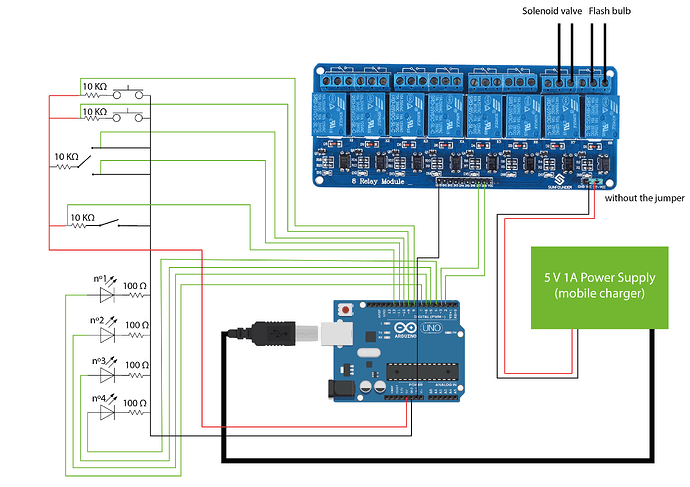Hi there
I am completely new to the world of electronics and Arduino, I have started with the purpose of facilitating the sequencing and execution of the special effects for a short film that I am making. I have some doubts about the circuit that I have designed and I would like to ask you, in case someone could give me a hand.
What I need is to create something similar to a pyrotechnic detonation panel/board to create the effect that someone has shot another person, for which I need to activate 2 systems: One of them is a solenoid valve of a pneumatic system that will propel fake blood through a tube placed inside the actor's shirt to simulate a bullet impact (what is called bullet hit squib) and the other system that I need to activate is a flash bulb that will simulate the flash of a gun.
For this I have designed the following circuit, with components that I have at home, ALL the LEDs used are for the following purposes, that is why they are connected in parallel:
LED nº1: Indicates if the Arduino has power
LED nº2: Indicates that the sequence is activated from button 1
LED nº3: Indicates that the sequence is activated from button 2
LED nº4: Indicates that the system is “armed”, that is, that the relays receive power and that pressing one of the buttons will activate the sequence.
Component specifications:
LEDs
1.8V-2V 20mA
Relay module
Single relay 5V 72mA
I have tried to follow good practices by powering the module and the rest of the systems separately from the Arduino, but I have the following doubts:
Is the relay module connected well so that it receives the signal from the arduino and activates?
Is the #4 LED that indicates if the relay module is receiving power connected correctly and will it serve its purpose without shorting anything?
Do you think the resistors are well placed and their value is more or less correct for their purpose? Should I add any other resistors or any other protection elements?
In general, do you think that the circuit will function in a stable and consistent manner (regardless of programming) as required for a shoot?
To power the solenoid valve, can I connect it directly to a 12V 1A transformer without any resistance (solenoid valve specifications: 12V 540mA)?
Any other suggestions would be greatly appreciated and would be greatly appreciated.
Thank you very much in advance ![]()


